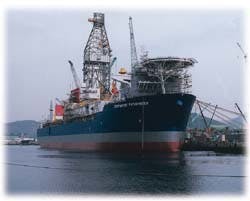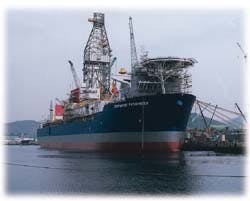Double-hull drillship, automated drilling, improve operability
Dean E. Gaddy
Drilling Editor
The /R&B Falcon drillship's dimensions are nearing that of the finished product, more than two football fields long and 30 stories high. The drillship is being constructed on Koje Island, South Korea, by Samsung Heavy Industries (Fig. 1)Structural design innovations and automated pipe handling equipment will improve the operability of a next-generation, ultra-deepwater drillship.
A double-hulled, fully automated drillship being built for Conoco Inc. and R&B Falcon Corp. is nearing completion and slated for sea trials in August 1998. It should begin service in December 1998 when it will be committed to a 5-year, $400 million drilling program in the Gulf of Mexico.
This is the first of two near-identical vessels that will be involved in Conoco's ultra-deepwater projects around the world (Fig. 1 [7,957 bytes]). When finished, the 721-ft long, 140-ft wide, and 66-ft deep vessel will be weighted at 103,000 dwt.
Terry Lucht, manager of well engineering and operations for Conoco, said technology transfer between Conoco's marine tanker and drilling groups led to innovative designs in the drillship's structure.
Conoco's marine group has extensive experience with a double-hulled, dynamically positioned shuttle tanker in the North Sea used to haul crude oil from the Heidrun platform, the world's first tension leg platform, to European refineries. "This is how we knew the technology would work," Lucht said.
The structural integrity of double-hulled ships is well regarded by the industry. Late last year, a barge rammed Conoco's double-hulled tanker, Guardian, while entering the Port of Lake Charles, La. Although there was a 400 sq ft gash that ripped through the ship's outer hull, the inner hull was undamaged and the oil cargo remained intact.
The drillship will be capable of drilling to 25,000 ft in water depths up to 7,500 ft. If needed, the vessel can later be fitted to drill in 10,000 ft of water by adding additional risers. The vessel's chief design consideration centers on exploratory well drilling, but it can also be used for development drilling programs. Eventually, it may serve as a floating production storage and offloading (FPSO) vessel.
Enabled with a triple-redundancy, dynamic-positioning system, the vessel will utilize six-azimuthing thrusters, providing 5,300 hp each. The thrusters will be linked with satellite and seabed systems that will serve to precisely position the vessel. The drillship will use variable-speed, fixed-pitch, ac-driven propellers to improve operating reliability and increase fuel efficiency.
The drillship is designed for continuous operation in a 10-year storm condition and will be able to withstand 60-knot winds and waves exceeding 18 ft.
Drilling systems will include:
- 750-ton, top drive
- 2 million-lb, 48 ft x 40 ft derrick with 1.5 million lb hookload capability
- 15,000-psi BOP system with multiplex and electro-hydraulic conrols
- Four 2,200-hp, 7,500-psi mud pumps
- 6,600-hp drawworks.
Automated pipe handling
The drillship will utilize an automated system of tubular management developed by Varco International (Fig. 2 [73,718 bytes]). The system has several components that work in tandem, controlled by an operator from an environmentally enclosed driller's cabin.The primary components include a conveyor, a pick-up/lay-down system (PLS), ac top drive, and a pipe-handling machine that includes an integrated iron roughneck. The system has the ability to bring stands to the drillfloor, raise them to the horizontal position, make up and rack triples off line, and rack back pipe.
Three individuals carry out the systems' operations, each of whom is responsible for different zones (Fig. 3 [90,501 bytes]). The driller controls the block and top drive, the assistant driller operates machinery for vertical racking and pipe handling (Fig. 4 [72,585 bytes]), and the pipe-deck handler controls the conveyor and pick-up/lay-down machine (knuckle-boom crane).
The driller and assistant driller operate out of the driller's cabin. The pipe-deck handler works from a terminal adjacent to the v-door.
The heart of the system is the pipe-handling machine, that includes an integrated iron roughneck. Using a remote-controlled, gateless torque wrench (Fig. 5 [105,698 bytes]), the integrated iron roughneck is capable of making and breaking tool joints that range in size from 4 in. to 93/4 in., from any height ranging from floor level to 20 ft above the drill floor. Thus, the pipe-handling machine will be able to provide backup torque for bottom-connections while drilling ahead, utilizing the height availability while handling the bottom hole assembly.
Two extending arms, positioned above the integrated iron roughneck, will move stands of drill pipe or collars toward or away from the machine (Fig. 6 [61,689 bytes]). Thus, drill collar and drill pipe stands will literally be picked up off the floor and placed in the set-back area or well center as needed.
Located at the end of each arm will be a jaw assembly designed to grip the outer body of the pipe or collar. Together, the two arms will be able to lift stands weighing up to 25,000 lb. Each jaw assembly will be equipped with a grip jaw for lifting tubulars and a roller jaw for guiding tubulars during the make-up of tool joints.
The arms will support and position stands from the racking area to the well's centerline through a combination of in-and-out movements and axial rotations about its vertical axis.
The pipe-handling machine is built around a two-column structure that will allow horizontal travel along one axis while rotating 90° clock or counter-clockwise. The horizontal position will be controlled by electric drives located under the monkeyboard and on the floor. These drives will be automatically positioned from the well centerline up to the selected finger positions. Manual manipulation will also be available.
Individual components, including torque wrench, spinner, and the lower and upper jaws, will travel vertically up and down these columns under the control of a single pair of hydraulic cylinders. A second set of cylinders will move the integrated iron roughneck assembly vertically in relation to the arms.
A remote-controlled fingerboard will support the pipe and collar stands in a conventional manner. In addition, a remote-controlled elevator working in tandem with power slips will allow the driller to grip and release the drillstring as required.
The PLS will provide the ability to remotely hoist tubulars from the v-door (near-horizontal) position to vertical, increasing drillfloor safety. Together with the pipe-handling machine, the PLS will virtually eliminate manual handling of tubulars on Conoco/R&B Falcon's drillfloor.
The PLS can hoist tubulars weighing up to 7,000 lb with a 20-in. OD, presenting them in a vertical orientation either at the well center or the auxiliary stand-building mousehole.
Varco's 1,150-hp ac top drive will also be an essential component in the drillship's integrated pipe-handling system. It has a hoisting capacity of 750 tons and a continuous drilling-torque rating of 63,000 ft-lb (93,000 ft-lb intermittent).
The top drive's pipe handler has a 360° rotating head, 100,000 ft-lb torque capacity, and a hydraulic forward and reverse-link tilt mechanism. The top-drive pipe handler and top-drive motor are used to break out and makeup internal blow-out preventer (IBOP) connections without the use of manual tongs, saving several hours of downtime during an IBOP changeout.
The machine operation will be controlled from Hitec ASA's enclosed driller's cabin mounted across the drill floor from the machine. The driller will be able to monitor and control the following functions:
- Torquing and spinning
- The machine's horizontal position
- The machine's rotational position
- The stand's vertical position
- The stand's position as it enters in and out of the racking platform's fingers
- Latching of the racking platform
- Vertical position of the torque wrench.
Operational capabilities
Operational capabilities will include the ability to handle subsea trees, drilling tubular risers, and casing through a 41 ft x 41 ft-wide moonpool. The drillship will have the flexibility to simultaneously drill and perform extended well tests.Instead of typical 45-ft long riser joints, 90-ft joints will be used. The 21-in. ID risers will be equipped with 4.5-in. ID, 15,000-psi choke/kill lines with a 3.8-in., 5,000 psi boost.
It will also incorporate a 2.56 million-lb, antirecoil, riser hangoff system. In addition, the drillship will have six 160,000 lbf, dual-riser tensioners with provisions for two more.
The drillship will be able to store 20,000 tons of materials on deck, compared with typical deck loads of 5,000 tons.
This storage capacity will play a large part in the vessel's logistical efficiency. Whereas current floating rigs require several supply boats for full-time support, Conoco's drillship will only need part-time support. Cranes will include an 85-ton unit and three 60-ton pedestal units.
Drilling fluid and fuel storage capacity includes:
- 34,000 cu ft bulk materials
- 10,000 sacks of chemicals
- 13,000 bbl drilling mud
- 18,000 bbl drill water
- 6,000 bbl brine
- 3,000 bbl oil-based mud
- 6,000 bbl potable water
- 28,000 bbl heavy fuel oil or diesel.
Heave compensating drawworks
The drillship will be installed with 6,600 hp, active-heave compensating drawworks (OGJ, July 21, 1997, p. 68).The electric drawworks is designed to counteract heave by winding wire off and on to the drum according to the motion of the vessel. Thus, if the ship heaves upward 3 ft, then 42 ft of wire will be reeled off the drum (14-line configuration).
This system will have two advantages over conventional traveling-block and crown-mounted compensators. First, it will eliminate the mechanical need for changes in weight or pressure to compensate for vessel movement. Second, because the system will be an integral part of the drawworks, the full-rated load of the traveling equipment can be utilized during compensation.
Sensors will be located in the derrick, dead-line, and on the hull next to the moonpool. The derrick's sensors will check the position of the blocks. The dead-line's sensor will monitor the hook-weight, and the hull's sensor will provide input to calculate the position of the rig floor as it moves.
Power will be used to lower the drillstring, eliminating the need for an active resistance brake normally used for heavy loads.
Plans
The vessel is owned by a 50-50 joint venture between Conoco and R&B Falcon (OGJ, Nov. 11, 1996, p. 34), and will be officially named by Conoco Gulf Coast employees during christening.Conoco and R&B Falcon's second drillship was ordered in May 1997 and is expected to be ready early in 1999. This additional drillship will be used for either partner on worldwide projects in West Africa, New Zealand, Gulf of Mexico, or elsewhere.
Conoco will have exclusive use of the first drillship for 5 years, and control of the second ship for the first half of its 5 year program. Both ships will have renewal options. The Gulf of Mexico drillship program centers on 60 blocks located in water depths between 2,000 and 9,000 ft.
Conoco has aggressively bid on acreage in the Gulf of Mexico. In 1996, 1997, and 1998, the company acquired 58, 71, and 121 blocks respectively in the Gulf of Mexico. Conoco has 287 blocks in waters deeper than 1,000 ft. Total acreage for the 287 blocks is 1.65 million acres.
Copyright 1998 Oil & Gas Journal. All Rights Reserved.

